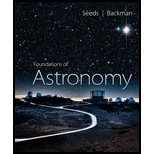
Describe four ways Venus is similar to Earth today. Describe four ways Venus is different from Earth today.
The four ways in which Venus is similar and different from Earth today.
Answer to Problem 1RQ
The four ways in which Venus is similar to Earth are similar mass and size, same average density, formed in the same part of solar nebula and similar orbits. It is different in having clockwise rotation, very dry surface, thick atmosphere and no measurable magnetic field.
Explanation of Solution
The four ways in which Venus is similar to Earth are similar mass and size, same average density, formed in the same part of solar nebula and similar orbits.
The diameter of Venus is
The four ways in which Venus and Earth are different are clockwise rotation, very dry surface, thick atmosphere and no measurable magnetic field.
Venus and Uranus are the only planets in the solar system that rotate in clockwise direction. The rest rotate in anti-clockwise direction. Venus’s surface is drier than Earth’s driest surface and a hundred times thick atmosphere than the Earth.
Want to see more full solutions like this?
Chapter 21 Solutions
Foundations of Astronomy (MindTap Course List)
- Lab 8 Part 3 PHET Wave Interface simulation. I am having trouble with this part of the lab.arrow_forwardMick and Rick are twins born on Earth in the year 2175. Rick grows up to be an Earth-bound robotics technician while Mick becomes an intergalactic astronaut. Mick leaves the Earth on his first space mission in the year 2200 and travels, according to his clock, for 10 years at a speed of 0.75c. Unfortunately, at this point in his journey, the structure of his ship undergoes mechanical breakdown and the ship explodes. How old is Rick when his brother dies?arrow_forwardHi, I have canceled, why did you charge me again?arrow_forward
 Foundations of Astronomy (MindTap Course List)PhysicsISBN:9781337399920Author:Michael A. Seeds, Dana BackmanPublisher:Cengage Learning
Foundations of Astronomy (MindTap Course List)PhysicsISBN:9781337399920Author:Michael A. Seeds, Dana BackmanPublisher:Cengage Learning
 AstronomyPhysicsISBN:9781938168284Author:Andrew Fraknoi; David Morrison; Sidney C. WolffPublisher:OpenStax
AstronomyPhysicsISBN:9781938168284Author:Andrew Fraknoi; David Morrison; Sidney C. WolffPublisher:OpenStax
 An Introduction to Physical SciencePhysicsISBN:9781305079137Author:James Shipman, Jerry D. Wilson, Charles A. Higgins, Omar TorresPublisher:Cengage Learning
An Introduction to Physical SciencePhysicsISBN:9781305079137Author:James Shipman, Jerry D. Wilson, Charles A. Higgins, Omar TorresPublisher:Cengage Learning Horizons: Exploring the Universe (MindTap Course ...PhysicsISBN:9781305960961Author:Michael A. Seeds, Dana BackmanPublisher:Cengage Learning
Horizons: Exploring the Universe (MindTap Course ...PhysicsISBN:9781305960961Author:Michael A. Seeds, Dana BackmanPublisher:Cengage Learning





